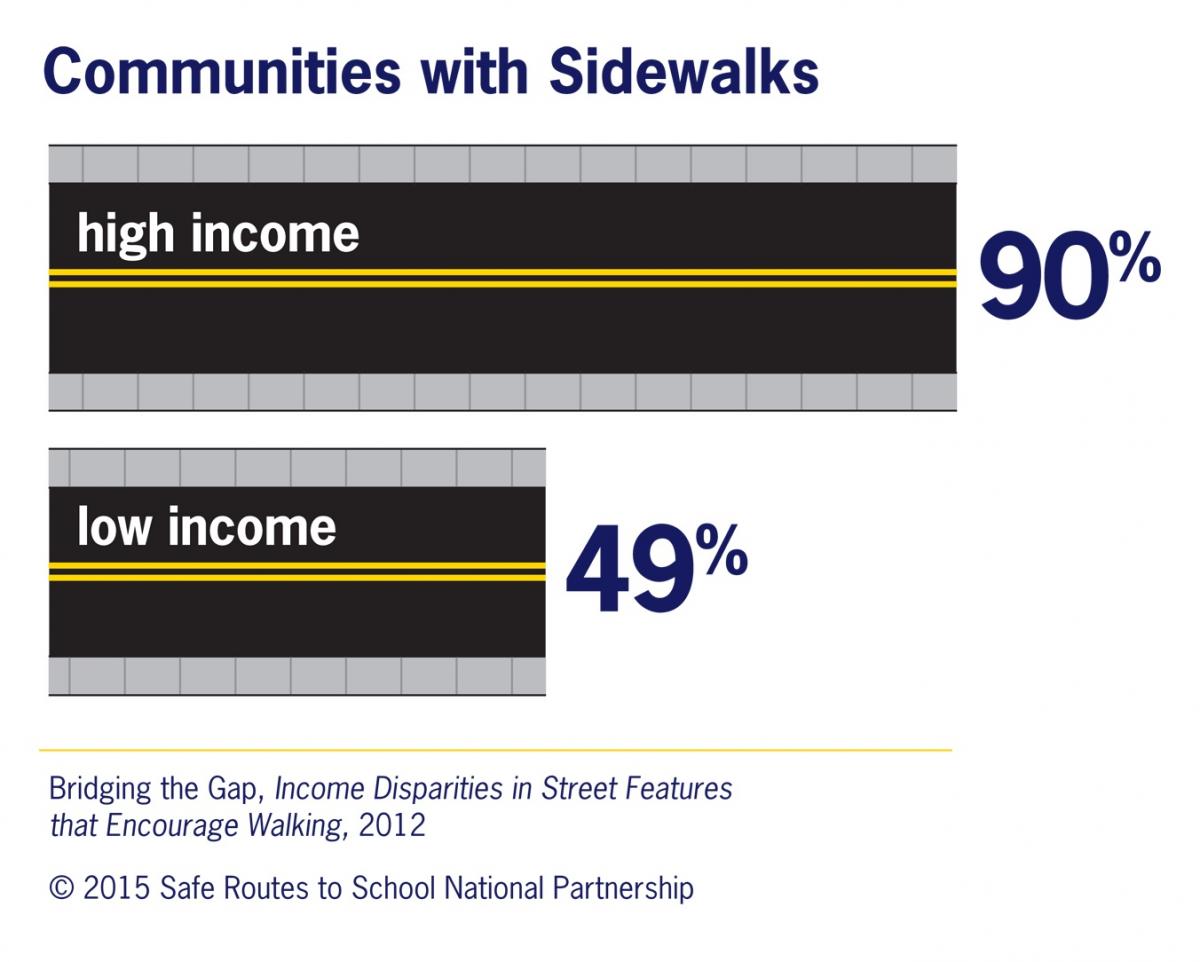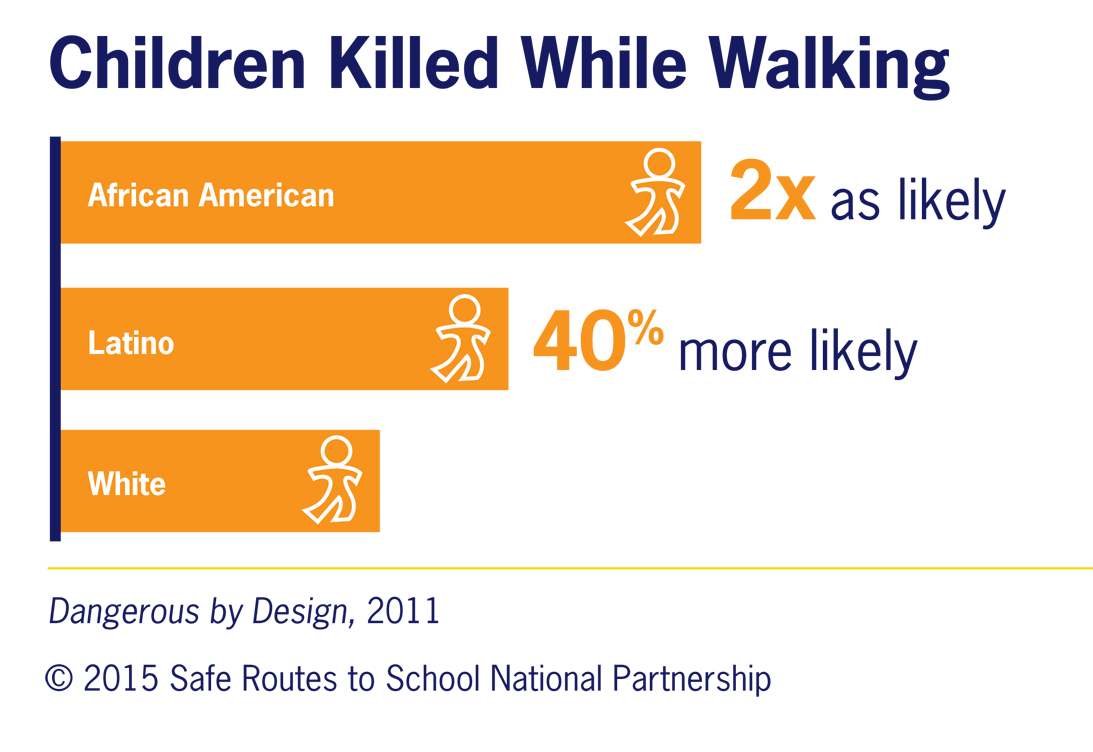Low-income and communities of color are full of life, cultural connectedness, and determination. In many homes, generations of the same family live together to share recipes, stories, and love. Neighbors relax on their porches and wave hello to walkers and bikers as they make their way to a friend’s house, school, or employment.
Increasing safe and convenient places to walk and bike in low-income and communities of color can help cement this sense of community, feelings of autonomy, and health. For many residents, walking and biking in these communities is a main way of travel to and from basic needs such as food, employment, and education, as opposed to walking and biking for recreation. Safe places to walk and bike are a huge contributor to the vibrant fabric of a community. At the same time, walking and biking to everyday destinations in low income and communities of color can be very daunting. Over the years, disinvestment during the budget process has caused maintenance of older infrastructure and creation of new infrastructure to go undone. This puts people in these communities at higher risk of injury and death while walking and biking to places they need to go, including youth who are walking and biking to school.


By prioritizing schools and communities with the highest need for safe walking and biking conditions, and education programs, equitable Safe Routes to School programs address inequities that stem from investment decisions that funneled funds to other uses, either within or outside of these communities. The inequities that have been created can span generations, often emerging along lines of race, ethnicity, class, gender, sexual orientation, and disability.
For example, children in low-income communities and those who are Latino and African American experience the highest obesity rates of any population group, and bear the burden of the most dangerous conditions for walking and biking – which discourages active transportation and leads to disproportionately high rates of walking and biking injuries. If generations of families live in the same community, year after year, they experience the same environment which can continue to contribute to these disparate outcomes.
Even when resources are made available for all communities through budget prioritizations or programs, such as Safe Routes to School, these communities can face many challenges associated with applying for and implementing Safe Routes to School grants. For instance, applying for a federally funded Safe Routes to School award through a state department of transportation can be a time-consuming endeavor requiring expertise and assistance from local planners and engineers, as well as coordination with the school district. Once a project is awarded funding, local award recipients must comply with federal regulations, which can require additional expertise and staffing to complete paperwork and submit for approvals. Additionally, the program is operated on a reimbursement basis, meaning that schools and localities must expend the funds and then wait for reimbursement.
These aspects can create challenges for low-income and communities of color in a number of ways. The communities are often underserved by government agencies and schools that are understaffed, meaning that their availability to spearhead a Safe Routes to School award may be limited. These agencies also face significant challenges in absorbing the costs of carrying out a Safe Routes to School project while waiting for reimbursement. Finally, community access to city or county engineering staff with the expertise necessary to implement the project and comply with federal and state regulatory processes is limited.
To help address inequities and increase service in low-income and communities of color, the Safe Routes to School program prioritizes Equity as one of its E’s. While Equity stands alone as its own E, it’s also important to build equity into each aspect of a comprehensive Safe Routes to School program. We have described how equity fits into all of the E’s in the summaries below.
Equity
Ensuring that Safe Routes to School initiatives are benefiting all demographic groups, with particular attention to ensuring safe, healthy, and fair outcomes for students with disabilities, low-income students, Native American students, students of color, female students, LGBTQ students, students whose families speak a language other than English, homeless students, and other demographic groups.
Education
Teaching students and community members about the broad range of transportation choices, and making sure they have the skills and know-how to be safe from traffic and crime while walking, bicycling, and using public transportation. Ensuring that education efforts address equity means assessing whether the recipients of services reflect the larger demographic pattern in the community, region, or state, and whether the content and lessons are engaging and useful for all student groups.
Encouragement
Using events and activities to promote walking, bicycling, public transportation, and physical activity. Encouragement activities can include new partnerships with faith-based groups, civil rights and neighborhood coalitions, and tenants’ organizations, as they build activities like walking school buses, walk to school events, bicycling incentives, and art and active transportation events. Addressing equity in encouragement means ensuring that encouragement activities are available to low-income students and students of color, as well as designing them to overcome the variety of obstacles to walking and bicycling that different kids experience. Encouragement activities should effectively influence children from different backgrounds to embrace walking and bicycling.
Engineering
Making physical improvements to the streetscape and built environment that decrease the risk of injury from motor vehicles and discourage crime and violence, increasing street safety for all. Equity requires community engagement and means that policies and investments ensure that physical improvements address street safety in low-income communities and communities of color, where sidewalks, bike lanes, lighting, and other safety features are often absent.
Encouragement
All Safe Routes to School initiatives should begin by listening to students, families, teachers, and school leaders and working with existing community organizations, and build intentional, ongoing engagement opportunities into the program structure.
Evaluation
Assessing which approaches are more or less successful; ensuring that a program or initiative is decreasing health disparities and increasing equity; identifying unintended consequences or opportunities to improve the effectiveness of an approach for a given community.

